Types of Catfish
North America is home to well over 30 catfish species. Many of the catfish species in North America are in isolated areas or small populations. Anglers call the most popular catfish species The Big Three. The Big Three include blue catfish, flathead catfish, and channel catfish.
The Big Three are the catfish species most anglers go looking for when they’re fishing. There are decent sized populations of other fish around North America as well, though. Whatever catfish species is the one you’re in the market for, it’s good to know how to tell them apart.
The types of catfish you want to catch affect many things. Obviously, the bait you’ll use is a factor. And of course, where you go fishing. When you fish will also be a factor. Some catfish are best caught at night. Some stick to deep water. Some are more difficult to catch at certain times of the year.
Knowing the difference between types of catfish is important. Knowing what catfish like to eat is integral to catching them. You need to know that some catfish species are not great for eating. Some are but only in the right conditions. Familiarize yourself with the different types of catfish and good luck.
Blue Catfish or Ictalurus Furcatus
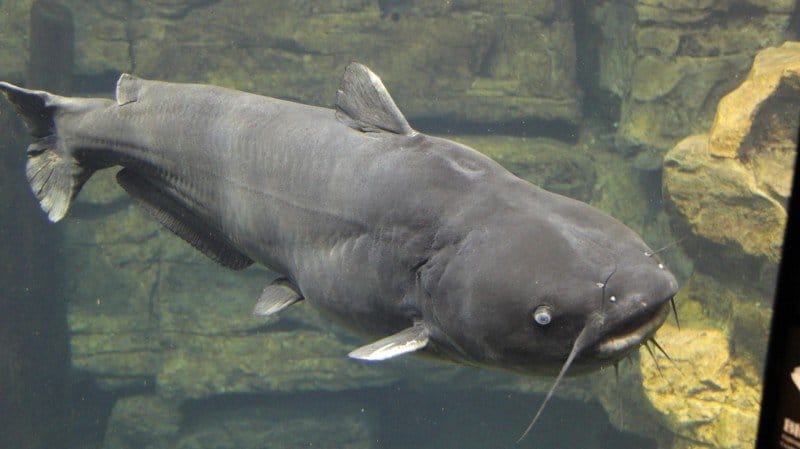
Blue catfish are the largest species of catfish in America. Anytime you see someone posing with a giant trophy cat, this is likely what they have. Some blue catfish can reach weights of 100 pounds to 150 pounds. The official record for the largest blue catfish ever caught is 143 lb. That catfish was caught in John Kerr Reservoir in North Carolina. Don’t go out expecting a monster catfish, though. Your average blue is maybe 40 pounds.
Unofficial stories of much bigger blue catfish exist. Some claim to have seen a blue catfish that weighed 300 pounds or more. While it’s possible such fish may exist, there’s no definitive proof. Even a blue that weighs 100 pounds will be rare.
Appearance
Blue catfish are very long fish. They can reach lengths of 60 inches or more. The belly of a blue catfish will be silvery-white. The rest is a grey or slate blue color, hence the name. They have a moderate but not deeply forked tail and flat dorsal fins. There are four pairs of prominent whiskers around their mouths as well.
Habitat
Blue catfish are often found in freshwater rivers in channels. They do well in deep water. They also enjoy swiftly moving water. They can adapt well to new habitats. In fact, they are invasive in parts of Virginia. Anglers introduced them to Virginia in the 1970s. Now they are one of the dominant catfish species in the area.
You can find blue catfish in the Missouri, Mississippi, and Ohio rivers. They’re also well-stocked across 20 states. Arguably, the most desirable American catfish is the blue.
Fishing
Fresh shad is an ideal bait for catching blue catfish. Science classifies blue catfish as opportunistic bottom-feeders. That means they eat almost anything. Their normal diet consists of anything from crabs to clams to vegetation.
Flathead Catfish or Pylodictis Olivaris
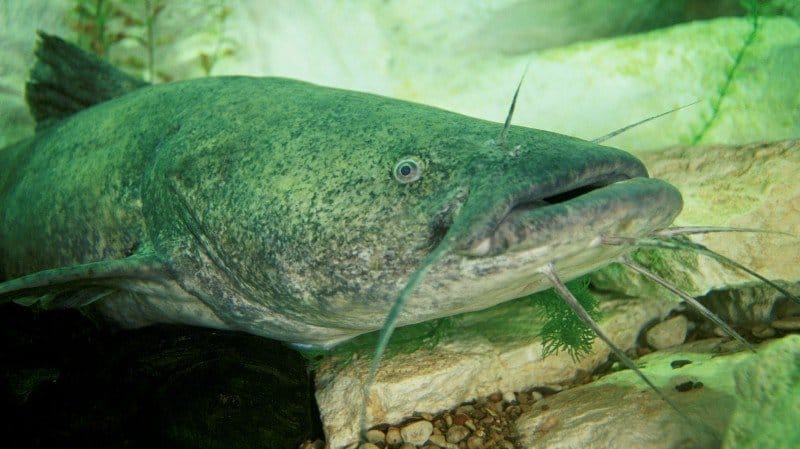
Flathead catfish are one of the most common species of cats in America. They range from Canada down to Mexico. Some people will call them Mudcats, Shovelhead Cats, and Johnny Cats.
Appearance
Flathead catfish are usually yellow to brown. As the name suggests, they have flat heads. Mottled and spotty ventral sides are common. Their underside is usually a creamy, pale yellow. Unlike some species, a squared-off and flat tale is characteristic of the breed. The distinctive lower jaw protrudes further than the upper jaw. They have a short anal fin with 14 to 17 spines.
Flathead cats can reach up to four feet in length. A respectable weight would be around 40 pounds. Some will also exceed 100 pounds. The largest ever caught weighed 123 lbs. It was caught in Elk City Reservoir, Kansas.
Habitat
Flatheads prefer to live in large bodies of water. Things like reservoirs and ponds. They can also be found in large rivers and tributaries. Unlike blue catfish, flathead catfish prefer slow-moving water. The geographic range includes the Mississippi River and the Great Lakes. You can catch them in Texas and most of the southern states. The Midwest is also home to a large population.
Fishing
Flathead catfish respond best to live bait. Smaller fish like perch, bluegill, and goldfish make great bait. Despite their love of live bait, cut bait also works. Their natural diet consists of small fish and invertebrates. Worms, crayfish, and insects all feature in their diet.
Channel Catfish or Ictalurus Punctatus
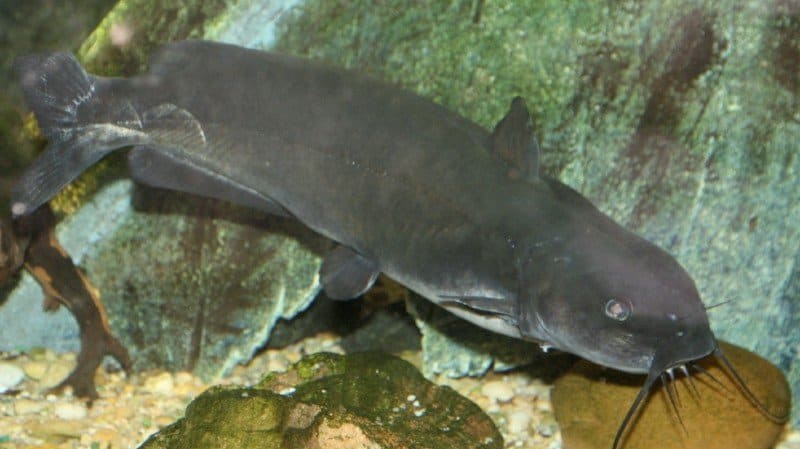
Channel catfish are the most abundant species of catfish in North America. Millions of anglers go out in search of these fish every single year. They’re the state fish of Iowa, Kansas, Missouri, Nebraska, and Tennessee.
Appearance
Channel catfish are smaller species of catfish than blue catfish or flathead catfish. Their weight rarely exceeds 40 pounds. Length is often around 24 inches. The largest channel catfish came from the Santee-Cooper Reservoir and weighed 58 lbs.
Channel catfish have blue to greenish-grey skin with dark spots. Their bellies are often white or silvery. They have a deeply forked tail. Like other types of catfish, they have four pairs of barbels around their mouths.
Habitat
You can find channel cats in the southern parts of Canada. They extend all the way down to Mexico. Channel cats are often found in streams and rivers, but also in ponds. Though some channel cats prefer murky water, you’ll often find channel catfish in clear water.
In recent years, channel catfish have appeared in Europe. They’re also in parts of Asia. They are one of the few types of catfish that are not considered invasive in most places.
Fishing
Channel cats are hearty eaters. In the wild, they feed on insects, crustaceans, and small fish. When fishing for them, a variety of baits work. Worms and chicken livers are especially successful with channel cats. Channel catfish may be the most popular species for eating. The meat is white or yellow and mild-tasting. Channel catfish is also sold commercially. You can find it fresh or frozen in many places.
White Catfish or Ameiurus Catus
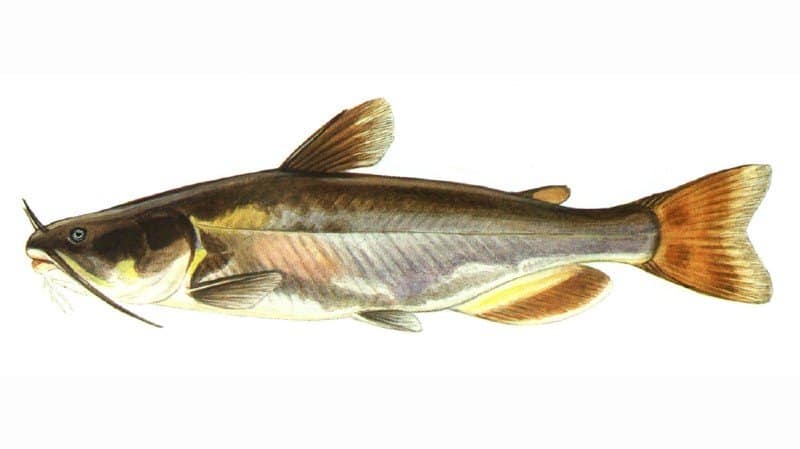
White catfish are also called white bullheads. It’s not uncommon to find them stocked in ponds in which you have to pay to fish. Though not as popular as channel catfish, they’re still prized for eating. There are several types of bullhead catfish aside from whites.
Appearance
White bullhead catfish look like smaller versions of flathead catfish. The most noticeable difference is their forked tails. Their bodies are shorter. The head may be a slate or olive-grey color. The belly is a pale white. The barbels on its chin will also be white. They have rounded anal fins with 19 to 23 spines.
Habitat
White catfish prefer clean waters. You can also find them in brackish waters. They live along the Atlantic seaboard. The range extends from New York down to Florida. White cats can also live along the Gulf Coast. Inland, you’ll find them stocked in places like Nevada, Illinois and, California.
Fishing
White catfish are diverse feeders. Anything from insects to mussels to fish eggs will appeal to them. You can catch them on a wide variety of baits from dip baits to even unusual ones like hot dogs. White catfish is an edible fish. The flesh is firm and white and slightly sweet. White catfish fries up well, but it can also be baked.
Yellow Bullhead or Ameiurus Natalis
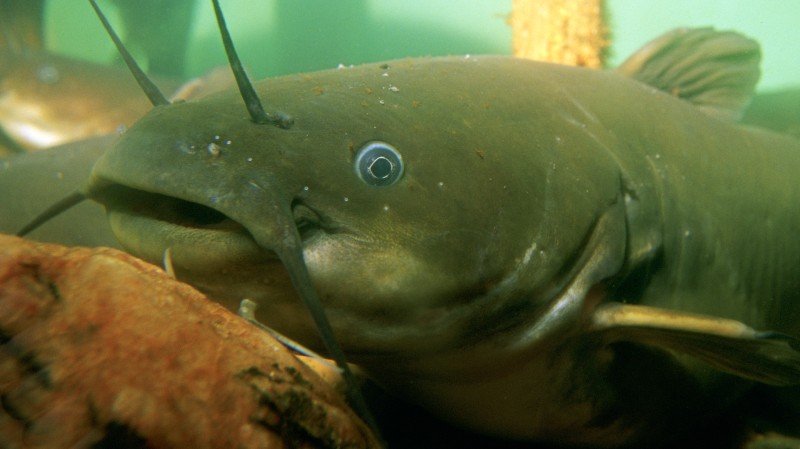
Yellow bullhead catfish are medium-sized, and their fins have many rays. The anal fin may have as many as 27. You can eat the yellow bullhead catfish and many people enjoy the flavor. That said, they’re still not as popular as most other catfish.
Appearance
As the name suggests, yellow bullhead catfish are often yellow. They can also be a dark black shade. The sides of the fish are usually the palest shade. Like most catfish, it has barbel whiskers on its face. You can tell a yellow bullhead from another bullhead because the whiskers are white.
Habitat
Yellow bullhead catfish can thrive in unpleasant waters. Muddy, polluted, and dark waters can all be home to yellow bullhead. They also thrive in fast-moving clean waters, though. Their typical range includes the Central and Eastern United States. You can find them as far north as the Great Lakes in Canada.
Fishing
Like other bullhead catfish, yellow bullheads are hearty eaters. You can catch them using natural baits like crickets and worms. They also respond well to chicken livers. You can easily catch them at night by fishing near the bottom. For your own well-being, it’s best not to eat yellow catfish caught in unclean water. Make sure the fish was from clean water and well-cleaned before eating.
Brown Bullhead or Ameiurus Nebulosus
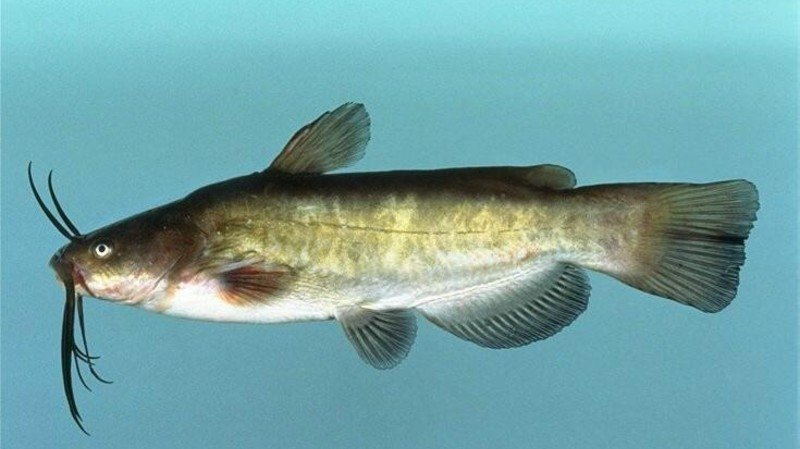
Also called Ictalurus nebulosus, the brown bullhead has several common names. These include Mudcat, Mud Pout, and Horn Pout. Nicknames for different types of catfish can get confusing, though. For instance, mudcat is also a name for flathead catfish.
Appearance
Despite the name, brown bullhead are often green in appearance. The back is the darkest and the color fades to green-brown down to yellow towards the sides and belly. The belly itself will often be white. The fish’s sides are also spotted.
The anal fin of the brown bullhead will have 21 to 24 rays. Their tail is flat with a notch. The barbels around their mouths are usually black or brown and yellow. Brown bullhead are usually under two feet in length.
Habitat
You can find brown bullhead in the northeastern United States and Canada. They are an important part of Native American tradition in that area. Hudson Bay, the Great Lakes, and the St. Lawrence River are all home to brown bullheads. They also live in the Mississippi Basin. Browns live in many states ranging from California to Idaho to Louisiana and even in Hawaii.
Fishing
Like other bullheads, different types of catfish baits work best for brown bullheads. Worms and chicken livers can be very successful. The flesh of this catfish is pleasant tasting and reddish-pink. It’s best to fish from clean waters if you plan to eat them.
Black Bullhead or Ictalurus Melas
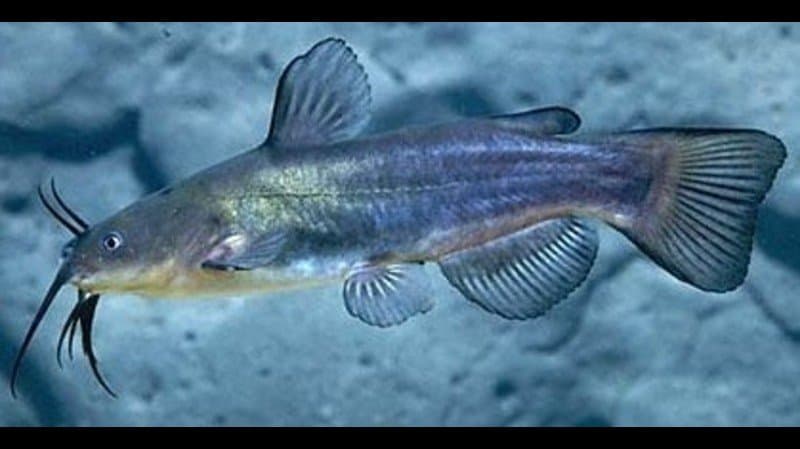
Black bullhead catfish are not usually fished for sport or food. Since they tend to be accidental catches, most anglers throw them back. Their behavior can get aggressive towards other fish.
Appearance
It can be easy to mistake the black bullhead for other catfish species. One way to identify the black bullhead catfish is the light-colored crescent at its tail. They also have black barbels around their mouths.
Black bullhead weigh between one and two pounds on average. They do not have a forked tail. Instead, their tail is square and flat with rounded edges. The anal fin has 19 to 25 rays. Its back will usually be black or dark brown. Along the ventral side of the color fades, and the belly is usually whitish silver.
Habitat
Black bullhead catfish can thrive in waters where other types of catfish cannot. Low oxygen and stagnant pools of water do not pose a problem for them. They can also thrive below dams and lake outlets. Deep water or shallow water are both home to these catfish.
Black bullhead catfish live throughout the United States. They are particularly abundant in the central part of the country.
Fishing
There is not a big interest in fishing for black bullhead catfish. The fish can be aggressive with bait fish and can often take over an entire pond unless there are bass present. Bass will feed on black bullhead catfish. That helps maintain a balance of fish species.
Black bullhead seemed to eat almost anything. Dead fish, live fish, insects, even greens. As with other bullhead catfish, they respond well to baits like worms and chicken livers.
You can eat the meat of the black bullhead catfish, but it’s best only to do so if they’re caught in clean water. The taste is actually quite pleasant but you may need to trim some yellow fatty meat.
Headwater Catfish or Ictalurus Lupus

Headwater catfish are not considered a game fish at all. Their range is limited in the United States. They are rarely fished for sport, but it does happen sometimes. They are one of the rarest types of catfish.
Appearance
Headwater catfish resemble channel catfish, only smaller. They rarely reach more than 20 inches in length. They have silver bellies and olive coloration along the sides. Brown spots are common. Headwater catfish anal fins have 23 to 26 rays. They have long mouths barbels for the fish’s size.
Habitat
Headwater catfish live in the Southwestern US and parts of Mexico. They’re fished up in places like the Rio Grande and the Pecos River. Unlike bullhead catfish, headwater catfish prefer clean water.
Fishing
Live baits work best with headwater catfish. Worms, cut bait, and punch bait can all have success. Though you can eat headwater catfish, they are often very small and provide little meat. Given the small size, it is best to throw them back in most cases.
Categories: Fishing

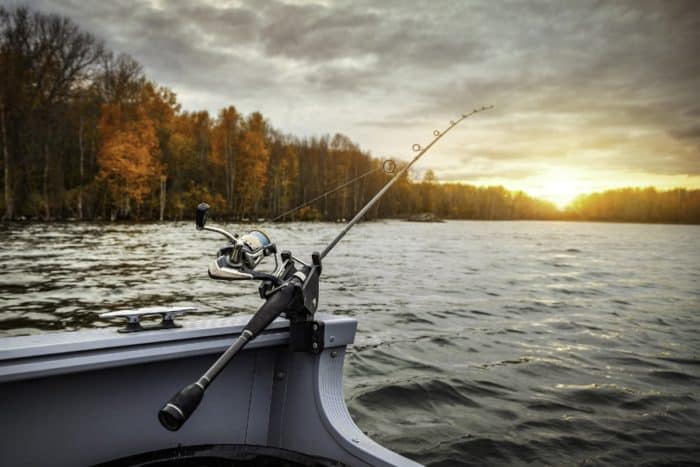

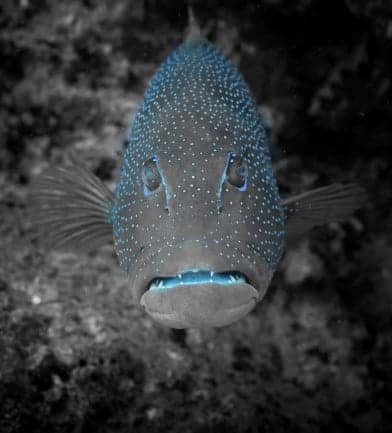








2 Comments
James on August 8, 2021
Caught 2 Headwater catfish in Pymatuning State Park on Pennsylvania side with worms yesterday.
kaiden on October 12, 2022
caught a channel catfish in a creek